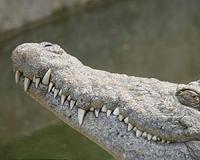| . |  |
. |
Riga (AFP) Aug 5, 2010 Latvia's capital Riga is offering cash prizes to residents who can come up with the best ideas for stopping a busy colony of beavers from destroying trees and bushes along its picturesque canal. "We have no problems with the beavers. We have a problem with them felling trees," city spokeswoman Dzintra Abolina told AFP on Thursday, recalling how a a 100-year-old oak nearly fell victim to the big-tooth semi-aquatic rodents. To solve the problem, the local parks and gardens department is offering 300 lats (425 euros, 560 dollars) for the best idea for stopping the beavers' destructive ways without actually harming them. "We are waiting for effective solutions to protect trees and bushes, but which at the same time would show a humane attitude toward the beavers," said the head of Riga's city environment department Vjaceslavs Stepanenko. Entries close on September 6 but already the city has received plenty of ideas, Abolina said. "Maybe other cities and towns in the world could share their experiences on how to deal with this problem," she added.
earlier related report The secretive military regime is believed to have set aside the entire Hukaung Valley, stretching around 8,450 square miles (21,970 square kilometres), to preserve the creatures. The move is a "major step forward" in saving the world's wild tiger population, which is thought to have fallen as low as 3,000, wild cat group Panthera and the Wildlife Conservation Society said in a statement this week. The groups said the valley had the potential to hold several hundred tigers, but added that illegal hunting of both the animals and their prey meant there could be as few as 50 in the region. As many as 100,000 tigers prowled the forests and grasslands of Asia just a century ago, but numbers have slumped dangerously low mainly because of poaching and loss of habitat. The Hukaung Valley is said to be one of the last examples of a closed forest in the region and the reserve could also protect other large mammals like clouded leopards and Asian elephants. Panthera chief executive Alan Rabinowitz said the announcement builds on the designation of a 2,500 square mile (6,500 square kilometre) tiger sanctuary in the valley in 2004. "This reserve is one of the most important stretches of tiger habitat in the world, and I am thrilled that the people and government of Myanmar understand the importance of preserving it," he said. The statement said "many years of hard work" had gone into persuading local ethnic groups, recent settlers and local businesses to agree to the plan. Conservationists are hopeful for the future of the animals. The statement said "tigers can make a comeback" if hunting of the creatures and their prey is tackled "effectively and immediately".
earlier related report Thousands of turtles used to land every year on Malaysian beaches, but their numbers plummeted in the 1980s due to rampant coastal development and the plundering of eggs from their sandy nests. However, landings have increased in the past few years in the eastern resort strip of Cherating, and some 350 -- mostly green turtles but also some hawksbills -- now arrive there each year, officials said. Mohamad Mat Saman, fisheries department director in central Pahang state, said that initiatives such as new hatcheries and efforts to promote conservation had led to the improvement. "This year up until June we had 200 turtles coming to lay their eggs," he told AFP. "About 70 percent of them had previously landed in Cherating and we believe others were born here. All turtles which land are tagged." "We received support from the locals and fishermen who collect turtle eggs and hand them to the sanctuary," he said. Mohamad said that authorities have proposed introducing a new law to ban turtle egg consumption in Pahang state by the end of this year. Turtle nesting sites are dotted along peninsular Malaysia's east coast, but the leatherbacks which were once common have now virtually disappeared. Elizabeth John from conservation group Traffic said that while some turtle populations now appear stable, their numbers have dropped dramatically since the 1970s. "Habitat loss is a major threat to green turtles and all other marine turtles that nest on Malaysian beaches. Infrastructure development along the coast near key nesting sites has impacted populations," she said. "The local trade and consumption of turtle eggs is another threat to green turtles," she added. John said green turtles are facing "the double whammy of losing their homes and their young", much as leatherback turtles did during the past few decades. "It's heartening to see green turtles still returning to nest on Malaysian shores, but if we fail to address the threats that face them, we will be pushing them go down the same path towards destruction," she said.
Share This Article With Planet Earth
Related Links Darwin Today At TerraDaily.com
 Mammal-Like Crocodile Fossil Found In East Africa
Mammal-Like Crocodile Fossil Found In East AfricaAthens OH (SPX) Aug 05, 2010 Fossils of an ancient crocodile with mammal-like teeth have been discovered in the Rukwa Rift Basin of Tanzania, scientists report in this week's issue of the journal Nature. The unusual creature is changing the picture of animal life at 100 million years ago in what is now sub-Saharan Africa. "If you only looked at the teeth, you wouldn't think this was a crocodile. You would wonder what ... read more |
|
| The content herein, unless otherwise known to be public domain, are Copyright 1995-2010 - SpaceDaily. AFP and UPI Wire Stories are copyright Agence France-Presse and United Press International. ESA Portal Reports are copyright European Space Agency. All NASA sourced material is public domain. Additional copyrights may apply in whole or part to other bona fide parties. Advertising does not imply endorsement,agreement or approval of any opinions, statements or information provided by SpaceDaily on any Web page published or hosted by SpaceDaily. Privacy Statement |